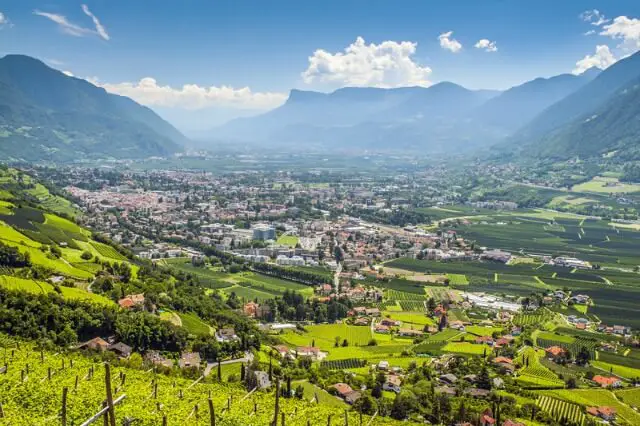Merano (Meran): A Brief Overview
Often celebrated for its thermal waters, the picturesque town of Merano (Meran), which is set at the entrance to the Vinschgau Valley (Val Venosta) and the Passeiertal Valley (Val Passiria), has long been popular with travellers seeking respite, relaxation and solace in nature. Merano is the Italian name; Meran is the German name of the town. About half the population speaks German and the other half Italian. A small minority also speaks Ladin. The surrounding mountain peaks which circle the entire town not only offer an impressively dramatic backdrop, but also present an irresistible allure to keen hikers looking to explore the spectacular alpine scenery.
The town has enjoyed a huge level of popularity throughout the history, largely due to the healing waters of its thermal baths. The water, which contains a level of radon, is reputedly excellent at helping with circulatory problems; though most visitors tend to simply enjoy taking some time to relax and while away a few hours in the warm spa baths! Merano has also enjoyed its fair share of famous visitors; including many scientists, and a few notable literary figures, such as Franz Kafka and Ezra Pound.
Exploring the Area Around Merano on Foot
The landscape around Merano is mostly mountainous, and as a result, there are plenty of excellent trails for walkers looking for a challenge. Of particular note are the Merano High Mountain Trail, one of the more famous routes in the area (the entire trail is 100km (62mi) long and takes around 4-6 days to complete) and the Merano High Alpine Route, whose northern section rises up to Mt. Eisjöchl (2,906m / 9,534ft).
There are also plenty of woodland areas and valleys to explore, which offer a more gentle range of walks and rambles, and many pretty mountain villages to visit along the way. The Texelgruppe Nature Reserve has many walking trails and some impressive flora and fauna, and visitors looking for a real challenge may want to tackle the mighty Mt. Roteck (3,337m / 10,948ft).
Things to do in Merano on a Rainy Day / Rest Day
This historic town has much to offer travellers who are looking for a day of rest and respite after some challenging walking. If you’re looking for something to do in Merano on a rainy or relaxing day, then visit the crumbling ruins of Polveria Castle to look over the old quarter of Merano, or alternatively, explore some of the numerous beautiful churches in the town; including the austere Church of St Nicholas, which dates back to the 15th century.
The Touriseum museum at Trauttmansdorff Castle is a really interesting place to visit during your stay, and is dedicated to all things South Tyrolean. The ticket also includes entry to the beautiful Trauttmansdorff Gardens next door. There’s also a thriving culinary scene, and of course, an excellent range of wineries in the near vicinity. In fact, the humble grape is so well regarded in Merano, that they even hold an annual festival in its name. If you want to see this spectacular event, which dates back to the 19th century, then make sure to visit the area around the third weekend of October.
The Thermal Baths of Merano
The thermal baths of Merano (Terme Merano) provide a highly unique and relaxing experience. The baths have varying temperatures and are located in various areas, from large halls to outdoor venues, surrounded by the mountains. In addition to the baths, there is also a Jacuzzi, steam bath and sauna to enjoy, which makes this an ideal way to ease aching muscles and relax in style during your stay.
Climate in Merano
Temperatures can get quite hot in the summer months, with highs of around 30˚; however, if you’re planning to walk in the mountains, the climate tends to be noticeably cooler. Temperatures in the Spring and Autumn tend to range between 15˚ to 25˚. The summer months may be considerably rainier than the winter months, so it is advisable to take appropriate clothing to avoid a drenching from a summer shower!
How to Get to Merano
Innsbruck and Verona international airports are both within a relatively short distance of Merano, with Verona only being 180km (about 50mi) away. The area is also well served by a regular train service to and from Bolzano, from which you can reach the airports and other cities and towns in the region.
If you’re travelling by car, the route is well signposted, simply leave the Brennaro motorway A22 at Bolzano and take the dual carriageway MEBO to Merano.

